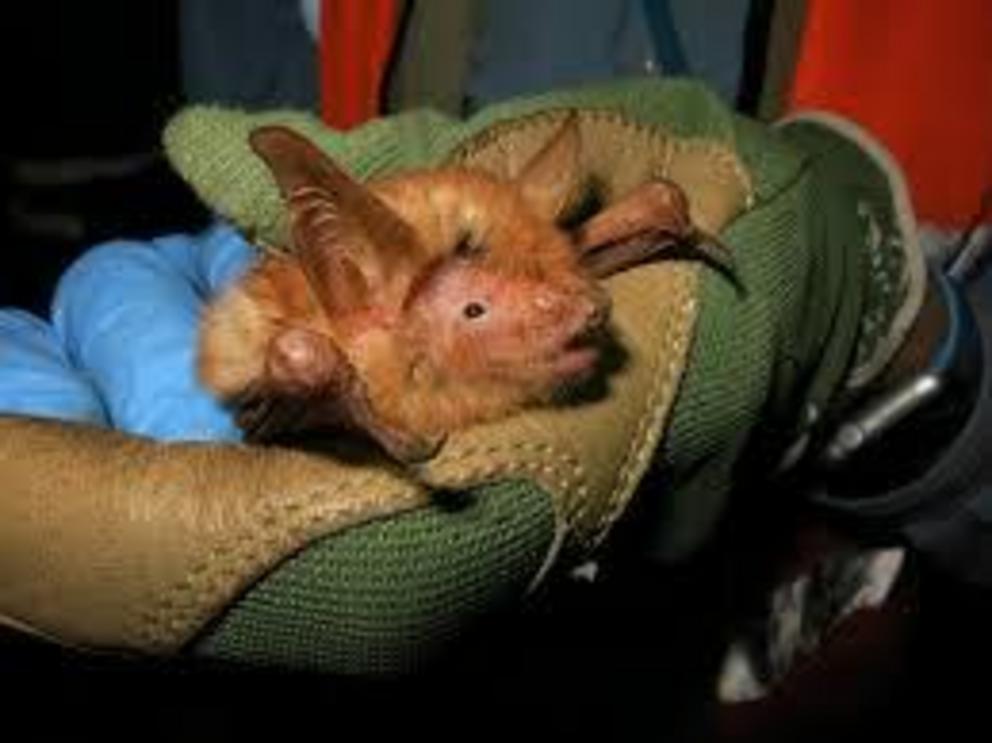'Spectacular' new orange-colored bat discovered in West Africa
Myotis nimbaensisis was named for the Nimba Mountains where it was found.
The newly described species is likely critically endangered.
A striking orange and black bat was discovered by researchers in Guinea's isolated Nimba Mountains in West Africa.1 The scientists were conducting field surveys in natural caves and mining tunnels when they first spotted the unusual species.
“While catching bats emerging from one of these sites we noticed a bat that looked very different from all the others,” co-author Jon Flanders, Bat Conservation International's director of endangered species interventions, tells Treehugger.
The bat looked nothing like the Lamotte's roundleaf bat, a critically endangered species found only in the Nimba Mountains.2
“It’s pretty spectacular — it’s bright orange in colour with black wings. Its fingers are pretty orange as well giving a fun contrast,” Flanders says.
“We spent a considerable time that night taking the bat’s measurements and going through the identification keys for the bats of Africa to see which species it was. But its features meant that it never keyed out to one specific species.”
The researchers returned to camp and consulted literature and still couldn’t identify it. They reached out to Nancy Simmons, a bat expert at the American Museum of Natural History, for help. She confirmed their suspicions that it was a new species.
"As soon as I looked at it, I agreed that it was something new," says Simmons, the lead author of the paper and Bat Conservation International Board member. "Then began the long path of documentation and gathering all the data needed to show that it's indeed unlike any other known species."
Biodiversity and Protection
The newly formed team of researchers from the American Museum of Natural History and Bat Conservation International worked together using echolocation, genetic data, and analysis of form and structure. They compared their data from collections at their museum, as well as the Smithsonian National Museum of Natural History and the British Museum.
The scientists described the new species, naming it Myotis nimbaensis, meaning "from Nimba" to acknowledge the mountain name where it is located.
The researchers believe it’s possible that the new discovery may only be the second bat species found in the Nimba Mountains. It's likely that the new species is critically endangered too, they said. They published their findings in the journal American Museum Novitates.1
The study is part of ongoing research working to help bats in the area survive. The original field surveys were part of an effort to identify the critical roles subterranean sites like natural caves and mining tunnels play for bat survival.
The Nimba Mountains are a chain of African “sky islands,” meaning they are isolated mountain ranges that rise out of a much lower land that resembles a sea.3 Their peaks rise about a mile (1,600-1,750 meters) about sea level and are home to “exceptional biodiversity,” say the researchers, including bats.
“The finding highlights the importance of the Nimba Mountains for biodiversity, this ‘sky island’ really is a biodiversity hotspot for the region,” says Flanders.
“It also highlights the importance of carrying out surveys like this — who knows how many other species are out that still haven’t been described? It’s also important because until you identify a species it’s impossible to protect it.”
For full references please use source link below.

